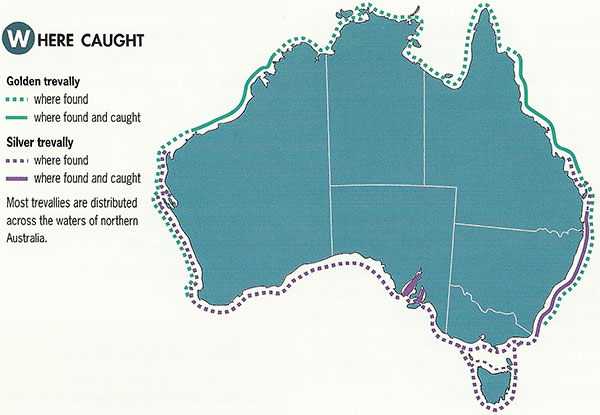Trevallies have a strong but not overpowering flavour.
They are great as sashimi and popular when served fried with chips.
Catch limits
| Catch limit | Fishing Mortality* | Biomass** |
|---|---|---|
Catch Limit (Incidental) 25 tonnes For the 2025–26 Season | Y;Uncertain | R;Overfished |
* Fishing mortality status relates to the level of fishing pressure on a stock – specifically, whether fishing mortality in the year being assessed is likely to result in the stock becoming overfished or prevent the stock from rebuilding from an overfished state. If fishing mortality exceeds either of these thresholds, a stock is considered to be subject to overfishing.
** Biomass status relates to how many fish there are – specifically, whether the biomass in the year being assessed is above the level at which the risk to the stock is considered to be unacceptable. The HSP defines this level as the limit reference point, below which the stock is considered to be overfished.
Scientific name: Pseudocaranx georgianus (formerly P. dentex)
Family: Carangidae
Other names: Silver bream, skippy, white trevally, skipjack trevally
Description: Silver trevally have moderately elongate and compressed bodies. The upper body is bluish silver, with yellowish silver sides and a silver belly. There is a small black blotch on the operculum (the hard bony flap covering the gills). Silver trevally have two dorsal fins, a deeply forked tail fin, and two small detached spines in front of the anal fin. Juveniles and sub-adults usually have a yellow mid-lateral stripe and a faint yellow stripe along the bases of the dorsal and anal fins.
Size (length and weight): Up to 1.2 metres and 18 kg. Commonly found at 35‑60 cm in length and 0.4‑2.5 kg.
Life span: Over 25 years.
Habitat: Silver trevally are a schooling species that inhabits estuarine and coastal waters. They can be found at depths of 10‑230 metres. Adult trevally inhabit inshore reefs and occur over open grounds of sand or gravel, or in large bays and inlets. Juveniles usually inhabit estuaries, bays and shallow continental shelf waters. Older fish sometimes school near the surface in deeper waters over the continental shelf, which may be associated with spawning.
Prey: Polychaete worms, molluscs, crustaceans (including krill).
Predators: Include seals and sharks.
Reproduction: Silver trevally reach reproductive maturity at 2‑4 years of age. Spawning occurs over an extended period from spring to autumn, in both estuaries and deeper waters. Silver trevally are serial spawners, with multiple batches of eggs being released over the spawning season. Females produce 50 000-200 000 eggs per spawning season.
Other notes: This species was previously confused with P. dentex, a larger tropical species which is not found in Australian waters.
| Fishery found in | Gear used | Catch of this species is targeted or incidental |
|---|---|---|
| Southern and Eastern Scalefish and Shark Fishery – Commonwealth Trawl Sector | Bottom trawl | Targeted |
| Southern and Eastern Scalefish and Shark Fishery – Great Australian Bight Trawl Sector | Bottom trawl | Incidental |
The Commonwealth catch of silver trevally is managed by quota, meaning that the catch of this fish by commercial fishers is restricted by weight.
Commercial fishermen are required to fill in records of their catches, during each fishing trip and when they land their catch in a port. This helps us keep records of how much is being caught.
AFMA decide on the amount that can be caught each year from expert advice and recommendations from fisheries managers, industry members, scientist and researchers.
Recreational catches of silver trevally are managed by the state authorities.
Silver trevally can be found in Western Atlantic, Eastern Atlantic and Indo-Pacific waters. Silver trevally occurs in bays and shallow continental shelf waters and often in areas of reef and rough bottom.
In Commonwealth waters, silver trevally are predominantly caught in waters at a depth of 50-120 metres in the Commonwealth Trawl Sector of the Southern and Eastern Scalefish and Shark Fishery. Very small incidental catches can also occur in the Great Australian Bight Trawl Sector.
Silver trevally are also a popular target species of recreational fishers off south-eastern Australia.

Fishers catch silver trevally using trawl nets.
Sometimes, bottom trawling can catch unwanted species of fish (not the type of fish the net was supposed to catch). This is known as bycatch and it is monitored by on-board fishery observers who assess the environmental impact of the trawling.
Although it is not physically possible to trawl on reef structures, significant long-term damage can occur if sensitive habitat areas like corals, sponges and seagrass beds are trawled. To ensure these sensitive habitat areas are protected from trawling, management arrangements such as area closures are extensively used.
AFMA’s management of commercial trawl fisheries aims to ensure trawl fishing has the least impact possible on the environment.
To reduce the impacts of fishing on the environment, AFMA have a number of management arrangements and strategies in place including:
- minimum mesh sizes for otter trawls to reduce the catch of small and juvenile fish
- mitigation devices to reduce interactions with threatened endangered and protected species
- closing some areas from fishing to protect vulnerable species and habitats.
Gear
Want to know more?
This is just an overview of silver trevally, if you want to know more see the links below.
This fish is managed under the Southern and Eastern Scalefish and Shark Fishery.